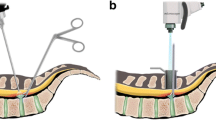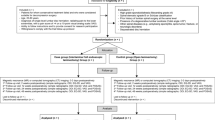Abstract
A Prospective randomised controlled study was done to determine statistical difference between the standard microsurgical discotomy (MC) and a minimally invasive microscopic procedure for disc prolapse surgery by comparing operation duration and clinical outcome. Additionally, the transferability of the results was determined by a bicentric design. The microscopic assisted percutaneous nucleotomy (MAPN) has been advocated as a minimally invasive tubular technique. Proponents have claimed that minimally invasive procedures reduce postoperative pain and accelerate the recovery. In addition, there exist only a limited number of well-designed comparison studies comparing standard microdiscotomy to a tubular minimally invasive technique that support this claim. Furthermore, there are no well-designed studies looking at the transferability of those results and possible learning curve phenomena. We studied 100 patients, who were planned for disc prolapse surgery at two centres [50 patients at the developing centre (index) and 50 patients at the less experienced (transfer) centre]. The randomisation was done separately for each centre, employing a block-randomisation procedure with respect to age and preoperative Oswestry score. Operation duration was chosen as a primary outcome parameter as there was a distinguished shortening observed in a preliminary study at the index centre enabling a sound case number estimation. The following data were compared between the two groups and the centres with a 12-month follow-up: surgical times (operation duration and approach duration), the clinical results, leg and back pain by visual analogue scale, the Oswestry disability index, length of hospital stay, return to work time, and complications. The operation duration was statistically identical for MC (57.8 ± 20.2 min) at the index centre and for MAPN (50.3 ± 18.3 min) and MC (54.7 ± 18.1 min) at the transfer centre. The operation duration was only significantly shorter for the MAPN technique at the index centre with 33.3 min (SD 12.1 min). There was a huge clinical improvement for all patients regardless of centre or method revealed by a repeated measures ANOVA for all follow-up visits Separate post hoc ANOVAs for each centre revealed that there was a significant time–method (MAPN vs. MC) interaction at the index centre (F = 3.75, P = 0.006), whereas this crucial interaction was not present at the transfer centre (F = 0.5, P = 0.7). These results suggest a slightly faster clinical recovery for the MAPN patients only at the index centre. This was due to a greater reduction in VAS score for back pain at discharge, 8-week and 6-month follow up (P < 0.002). The Oswestry-disability scores reached a significant improvement compared to the initial values extending over the complete follow-up at both centres for both methods without revealing any differences for the two methods in either centre. There was no difference regarding complications. The results demonstrate that a shorter operation duration and concomitant quicker recovery is comprehensible at an experienced minimally invasively operating centre. These advantages could not be found at the transfer centre within 25 minimally invasive procedures. In conclusion both procedures show equal mid term clinical results and the same complication rate even if the suggested advantages for the minimally invasive procedure could not be confirmed for the transfer centre within the framework of this study.




Similar content being viewed by others
References
Andrews DW, Lavyne MH (1990) Retrospective analysis of microsurgical and standard lumbar discectomy. Spine 15:329–335. doi:10.1097/00007632-199004000-00015
Bärlocher F (1999) Biostatistik. Georg Thieme Verlag, Stuttgart
Brayda-Bruno M, Cinnella P (2000) Posterior endoscopic discectomy (and other procedures). Eur Spine J:9
Brock M, Kunkel P, Papavero L (2008) Lumbar microdiscectomy: subperiosteal versus transmuscular approach and influence on the early postoperative analgesic consumption. Eur Spine J 17:518–522. doi:10.1007/s00586-008-0604-2
Bruske-Hohlfeld I, Merritt JL, Onofrio BM et al (1990) Incidence of lumbar disc surgery: a population-based study in Olmsted County, Minnesota, 1950–1979. Spine 15:31–35. doi:10.1097/00007632-199001000-00009
Caspar W (1977) A new surgical procedure for lumbar disc herniation causing less damage through a microsurgical approach. In: Wüllenweber R, Brock M, Hamer J (eds) Springer, Berlin, pp 74–77
Destandau J (1999) A special device for endoscopic surgery of lumbar disc herniation. Neurol Res 21:39–42
Fairbank JC, Pynsent PB (2000) The Oswestry disability index. Spine 25:2940–2952. doi:10.1097/00007632-200011150-00017
Foley KT, Smith MM (1997) Microendoscopic discectomy. Tech Neurosurg 3:301–307
Fountas KN, Kapsalaki EZ, Feltes CH et al (2004) Correlation of the amount of disc removed in a lumbar microdiscectomy with long-term outcome. Spine 29:2521–2524. doi:10.1097/01.brs.0000145413.79277.d0
Gibson JNA, Waddell G (2007) Surgical interventions for lumbar disc prolapse: updated cochrane review. Spine 32:1735–1747
Goffin J (1994) Microdiscectomy for lumbar disc herniation. Clin Neurol Neurosurg 96:130–134. doi:10.1016/0303-8467(94)90046-9
Greiner-Perth R, Bohm H, El SH (2002) Microscopically assisted percutaneous nucleotomy, an alternative minimally invasive procedure for the operative treatment of lumbar disc herniation: preliminary results. Neurosurg Rev 25:225–227. doi:10.1007/s10143-002-0220-2
Greiner-Perth R, Bohm H, ElSaghir H, El GA (2002) The microscopic assisted percutaneous approach to posterior spine—a new minimally invasive procedure for treatment of spinal processes. Zentralbl Neurochir 63:7–11. doi:10.1055/s-2002-31582
Hoogland T, Mayer HM, Brock M, Kambin P (1993) Percutaneous endoscopic discectomy. J Neurosurg 79:967–970. 5
Huang TJ, Hsu RWW, Lee YY, Chen SH (2001) Video-assisted endoscopic lumbar discectomy. Surg Endosc 15:1175–1178. doi:10.1007/s004640090125
Jansson KA, Nemeth G, Granath F, Blomqvist P (2004) Surgery for herniation of a lumbar disc in Sweden between 1987 and 1999. An analysis of 27 576 operations. J Bone Joint Surg Ser B 86:841–847
Keskimäki I, Seitsalo S, Österman H, Rissanen P (2000) Reoperations after lumbar disc surgery. Spine 25:1500–1508. doi:10.1097/00007632-200006150-00008
Kotil K, Tunckale T, Tatar Z, Koldas M, Kural A, Bilge T (2007) Serum creatine phosphokinase activity and histological changes in the multifidus muscle: a prospective randomized controlled comparative study of discectomy with or without retraction. J Neurosurg Spine 6:121–125. doi:10.3171/spi.2007.6.2.121
Krämer J, Ludwig J (1999) Surgical treatment of lumbar disc herniation. Indication and methods. Orthopade 28:579–584
Malter AD, McNeney B, Loeser JD, Deyo RA (1998) 5-year reoperation rates after different types of lumbar spine surgery. Spine 23:814–820. doi:10.1097/00007632-199804010-00015
Mannion AF, Junge A, Fairbank JC, Dvorak J, Grob D (2006) Development of a German version of the Oswestry Disability Index. Part 1: cross-cultural adaptation, reliability, and validity. Eur Spine J 15:55–65. doi:10.1007/s00586-004-0815-0
Mannion AF, Junge A, Grob D, Dvorak J, Fairbank JC (2006) Development of a German version of the Oswestry Disability Index. Part 2: sensitivity to change after spinal surgery. Eur Spine J 15:66–73. doi:10.1007/s00586-004-0816-z
Maroon JC, Onik G, Sternau L (1989) Percutaneous automated discectomy. A new approach to lumbar surgery. Clin Orthop Relat Res 238:64–70
Muramatsu K, Hachiya Y, Morita C (2001) Postoperative magnetic resonance imaging of lumbar disc herniation: Comparison of microendoscopic discectomy and love’s method. Spine 26:1599–1605. doi:10.1097/00007632-200107150-00022
Nakagawa H, Kamimura M, Uchiyama S, Takahara K, Itsubo T, Miyasaka T (2003) Microendoscopic discectomy (MED) for lumbar disc prolapse. J Clin Neurosci 10:231–235. doi:10.1016/S0967-5868(02)00337-5
Oppel F, Schramm J, Schirmer M (1977) Results and complicated courses after surgery for lumbar disc herniations. In: Wüllenweber R, Brock M, Hamer J (eds) Springer Verlag, Berlin, pp 36-51
Österman H, Seitsalo S, Karppinen J, Malmivaara A (2006) Effectiveness of microdiscectomy for lumbar disc herniation: A randomized controlled trial with 2 years of follow-up. Spine 31:2409–2414. doi:10.1097/01.brs.0000239178.08796.52
Österman H, Sund R, Seitsalo S, ki I (2003) Risk of multiple reoperations after lumbar discectomy: A population-based study. Spine 28:621–627. doi:10.1097/00007632-200303150-00019
Perez-Cruet MJ, Foley KT, Isaacs RE et al (2002) Microendoscopic lumbar discectomy: technical note. Neurosurgery 51:S129–S136
Ruetten S, Komp M, Godolias G (2005) An extreme lateral access for the surgery of lumbar disc herniations inside the spinal canal using the full-endoscopic uniportal transforaminal approach-technique and prospective results of 463 patients. Spine 30:2570–2578. doi:10.1097/01.brs.0000186327.21435.cc
Ruetten S, Komp M, Merk H, Godolias G (2007) Use of newly developed instruments and endoscopes: Full-endoscopic resection of lumbar disc herniations via the interlaminar and lateral transforaminal approach. J Neurosurg Spine 6:521–530. doi:10.3171/spi.2007.6.6.2
Ruetten S, Komp M, Merk H, Godolias G (2007) Use of newly developed instruments and endoscopes: Full-endoscopic resection of lumbar disc herniations via the interlaminar and lateral transforaminal approach. J Neurosurg Spine 6:521–530. doi:10.3171/spi.2007.6.6.2
Ruetten S, Komp M, Merk H, Godolias G (2008) Full-endoscopic interlaminar and transforaminal lumbar discectomy versus conventional microsurgical technique: a prospective, randomized, controlled study. Spine 33:931–939. doi:10.1097/BRS.0b013e31816c8af7
Schwetlick G (1998) Microsurgery in lumbar disk operations. Possibilities, methods and results. Orthopade 27:457–465
Türeyen K (2003) One-level one-sided lumbar disc surgery with and without microscopic assistance: 1-year outcome in 114 consecutive patients. J Neurosurg 99:247–250
Weinstein JN, Tosteson TD, Lurie JD et al (2006) Surgical vs nonoperative treatment for lumbar disk herniation. The Spine Patient Outcomes Research Trial (SPORT): A randomized trial. JAMA 296:2441–2450. doi:10.1001/jama.296.20.2441
Williams RW (1978) Microlumbar discectomy. A conservative surgical approach to the virgin herniated lumbar disc. Spine 3:175–182. doi:10.1097/00007632-197806000-00015
Wu X, Zhuang S, Mao Z, Chen H (2006) Microendoscopic discectomy for lumbar disc herniation: Surgical technique and outcome in 873 consecutive cases. Spine 31:2689–2694. doi:10.1097/01.brs.0000244615.43199.07
Yasargil M (1977) Microsurgical operation of the herniated lumbar disc. In: Wüllenweber R, Brock M, Hamer J (eds) Springer, Berlin, pp 81–84
Author information
Authors and Affiliations
Corresponding author
Additional information
J. Franke and R. Greiner-Perth contributed equally to this work.
Rights and permissions
About this article
Cite this article
Franke, J., Greiner-Perth, R., Boehm, H. et al. Comparison of a minimally invasive procedure versus standard microscopic discotomy: a prospective randomised controlled clinical trial. Eur Spine J 18, 992–1000 (2009). https://doi.org/10.1007/s00586-009-0964-2
Received:
Revised:
Accepted:
Published:
Issue Date:
DOI: https://doi.org/10.1007/s00586-009-0964-2




